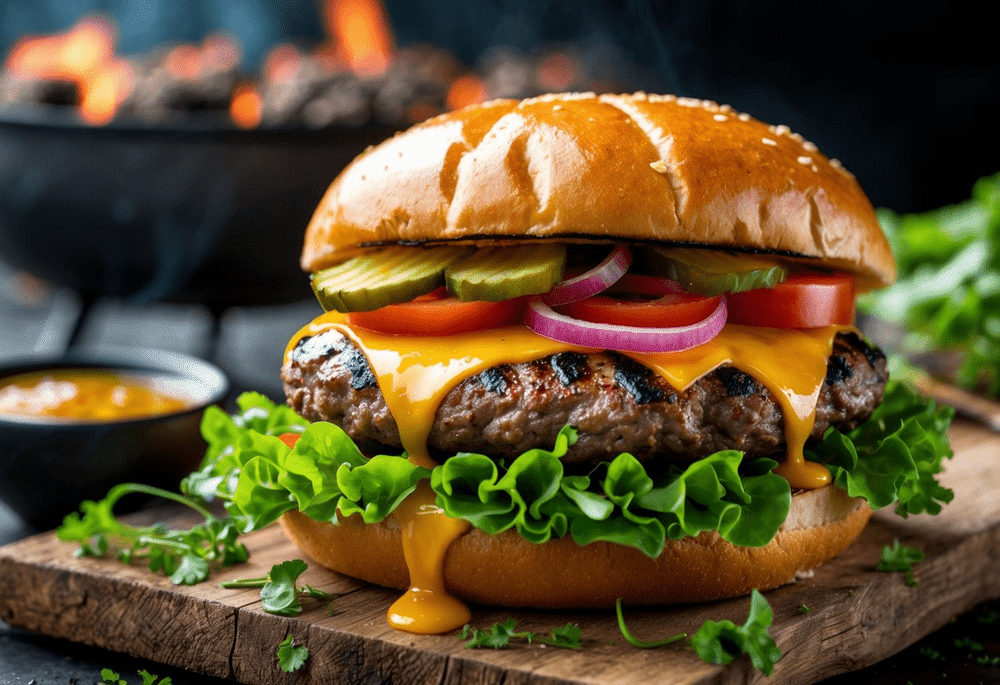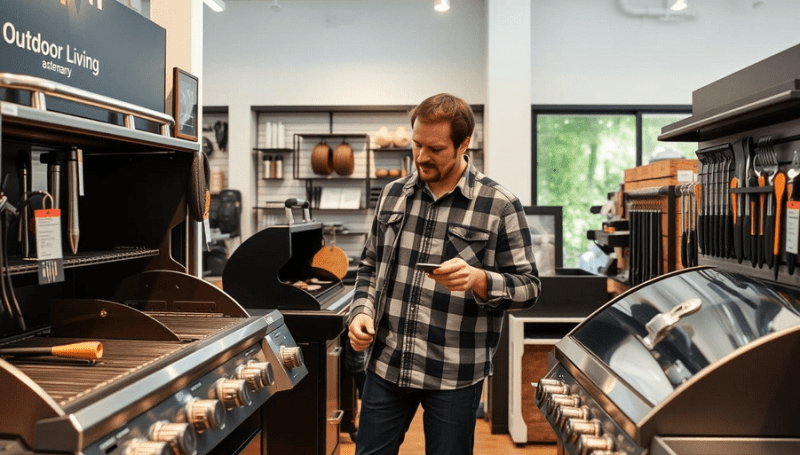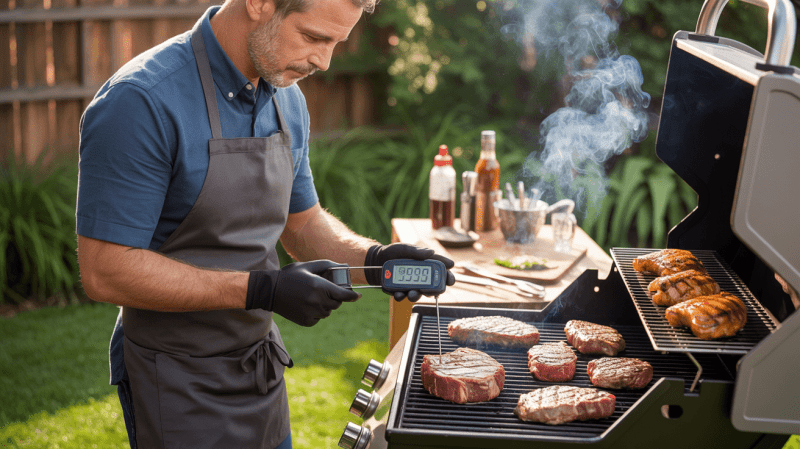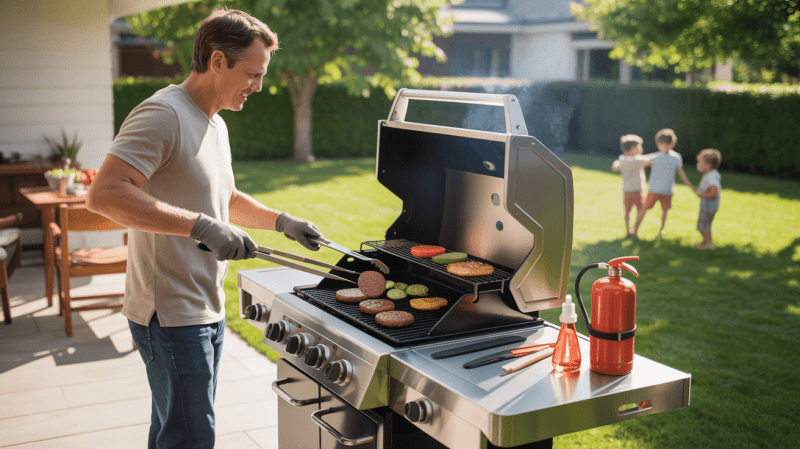Unlock the flavors that take your grilling game up a notch:
Grilling the perfect burger isn’t just about tossing a patty on the fire. You’ve got to pick the right meat with enough fat, season it well, and pay attention to how you grill it.
Ground beef with about 15-20% fat keeps burgers juicy and full of flavor, plus it cooks up nice and even.

The way you shape and handle the patty matters for texture. Gently shape the meat and make a little dip in the center—this keeps it from puffing up weirdly.
Preheat your grill and flip the burger at the right time. These steps help lock in juiciness and give you that killer sear.
Choosing the right bun and toppings makes a big difference. Sometimes just a soft bun and fresh toppings are all you need to let the meat shine.
Key Takeways
- Use ground beef with the right fat content for juicy burgers.
- Handle patties gently and control the grill for even cooking and tenderness.
- Pick buns and toppings that add to the burger without stealing the spotlight.
Choosing the Right Meat and Fat Content
Picking the right meat and fat level is huge for juicy, flavorful burgers. The fat ratio affects how moist your burger turns out. If you want to experiment, you can swap in other meats to change up the flavor and texture.
Selecting the Best Ground Beef
Ground chuck is a go-to for burgers. It’s got a great balance—usually 80% lean, 20% fat—which means it’s moist and flavorful without turning greasy.
Lean beef, like 90/10, can get dry if you’re not careful. You might need to add diced onions or a splash of oil to help with moisture.
Freshly ground beef or grinding it at home gives better texture. Don’t overwork the meat when forming patties, or you’ll end up with hockey pucks instead of burgers.
Understanding Fat Ratios for Juiciness
Fat is what keeps burgers juicy and tasty. Most folks swear by 20-25% fat—enough to melt and baste the meat as it cooks.
If you go above 30% fat, the patties shrink a lot and can fall apart. Drop below 15% and you risk a dry, bland burger.
Honestly, 80/20 beef just hits the sweet spot. It gives you moisture and flavor without turning into a greasy mess.
Alternative Meat Options
Ground turkey and lamb mix things up. Turkey’s lean, usually 85/15, so you’ll want to add cheese or sauce to dodge dryness.
Lamb brings a richer, almost gamey flavor and usually comes in at 80/20 fat. Pair it with toppings that can stand up to its boldness.
Mixing meats—like beef with pork or lamb—can boost flavor and let you tweak fat levels. Plant-based patties need their own tricks to get juicy, but that’s a whole other topic.
Flavor Boosters and Seasoning Secrets
The right seasonings and flavor boosters make burgers pop. Simple, smart ingredients can balance flavors without drowning out the meat.
Essential Burger Seasonings
You don’t need a mile-long spice list. Garlic powder and onion powder add depth, while smoked paprika brings a gentle smokiness.
Kosher salt and black pepper are non-negotiable. Salt helps hold in moisture, and pepper gives a little bite.
Here’s a solid blend to try:
- 1 Tbsp sweet paprika
- 1 Tbsp smoked paprika
- 1 Tbsp kosher salt
- 2 tsp black pepper
- 1 tsp garlic powder
- 1 tsp onion powder
Sprinkle it on the outside or mix it into the meat—either way works. Just don’t overdo it.
Enhancing Flavor with Worcestershire Sauce and Olive Oil
A splash of Worcestershire sauce brings a savory punch and a little tang. About a tablespoon per pound of beef does the trick without making things soggy.
Olive oil helps bind seasonings and adds moisture. It also helps with browning. One tablespoon per pound is plenty.
These two together? They really boost the flavor and keep the burger juicy.
Marinating and Blending Techniques
Marinating ground beef isn’t super common, but it can work if you keep it short—30 minutes tops. Letting the seasonings sit a bit helps the flavors sink in.
Blend the seasoning gently. Overmixing leads to dense, tough patties, and no one wants that.
You can mix seasoning into the meat or just dust the outside before cooking. Both ways have their fans.
Mastering Patty Formation and Grilling Techniques
Building a great burger patty and grilling it right takes a little focus. Shaping, handling, and cooking each play a part in how juicy your burger ends up.
Forming Juicy, Tender Patties
For juicy burgers, stick with beef that’s about 20% fat. Shape the patties gently—about ¾ inch thick is good.
Don’t mash the meat together too much. That just makes them tough. Put a little dip in the center so they don’t balloon up on the grill.
Make the patties a tad bigger than your buns because they shrink as they cook. That’s just how it goes.
Keeping Meat Cold and Handling Tips
Cold meat holds together better and keeps the fat from melting out early. Keep the beef in the fridge until you’re ready to shape it.
Work quickly and don’t over-handle. After shaping, you can chill the patties again before grilling. Skip smashing them with a spatula while they cook—it just squeezes out the good stuff.
Grilling for the Perfect Crust
Crank up the heat for a good sear. A hot grill or a cast-iron pan is your friend here.
Set the patties down and let them be for a few minutes so they brown up. Flip just once, usually after 3–5 minutes, depending on size.
Use a wide spatula and turn them gently to keep them intact. This helps lock in those juices.
Measuring Doneness with a Meat Thermometer
If you want to be sure about doneness, use a meat thermometer. Stick it right into the center of the patty.
Here’s a quick guide:
| Doneness | Internal Temp (°F) |
|---|---|
| Medium-Rare | 130 - 135 |
| Medium | 140 - 145 |
| Medium-Well | 150 - 155 |
| Well-Done | 160+ |
Pull the burgers off the grill just before they hit your target temp. They’ll finish cooking as they rest, and you won’t end up with dry patties.
The Ultimate Build: Buns, Toppings, and Serving

Buns, toppings, and condiments can totally make or break your burger. Each one adds something to the mix—texture, flavor, or just making sure the burger holds together.
Choosing and Preparing Burger Buns
Buns should be soft but sturdy enough to handle all the fillings. Brioche buns are a favorite—just sweet enough, with a slightly firm crust that doesn’t get soggy.
Toast the buns on the grill or in a skillet for a bit of crunch. Try to match the bun size to the patty so every bite is balanced.
Honestly, buns with a hint of sweetness like brioche or potato buns work well. If the bun’s too big, it overpowers the burger. Too small, and everything spills out. That’s just annoying.
Topping Selection and Classic Combinations
Toppings bring crunch, freshness, and a hit of flavor. Classic picks? Crisp lettuce, ripe tomato, onions, and pickles.
Raw onions give a sharp bite, while caramelized onions add sweetness. Bacon gives you smokiness and crunch, and avocado brings creaminess and healthy fat.
Mix and match these for layers of texture and taste. Lettuce for crunch, onions for depth, bacon for that salty, smoky kick. It’s all about finding your own favorite combo.
Condiments and Final Touches
Sauces and condiments really pull the flavors together in a burger. Mayonnaise works as a classic base, giving creaminess without stealing the show.
Ketchup or mustard adds a bit of tang. If you're feeling adventurous, try something like chipotle mayo or garlic aioli for a twist.
I like to spread condiments evenly on both bun halves. It keeps things from getting soggy and makes every bite balanced.
The sauce should lift up the meat, cheese, and toppings—not hide them. Nobody wants a burger where you can't taste the main event.
Finishing touches make a difference. A slice of melted American cheese or a patty crowned with gooey cheese just ties it all together.
Frequently Asked Questions

Great burger flavor comes down to the right spices and a gentle touch. The cooking time and the type of beef you use really matter for juiciness and texture.
Grilling the burger right and picking a good bun can make the whole thing better. Sometimes it's the little details that count.
What are the key spices to include for a flavorful burger patty?
Salt and black pepper are must-haves—they let the beef shine. Garlic powder and onion powder add a little extra depth but don't take over.
If you want a bit of heat, try a pinch of smoked paprika or cayenne. It's all about balance and what you like.
How long should you grill burgers for the perfect doneness?
A half-pound burger usually needs about 3 to 4.5 minutes per side on medium-high heat. Thicker patties or a cooler grill might take longer.
Shoot for an internal temp of 140-145°F for medium. Always check with a thermometer if you're unsure.
What type of ground beef yields the juiciest burger?
An 80/20 blend—80% lean, 20% fat—makes the juiciest burgers. The fat keeps things moist and flavorful.
Go much leaner and the burgers dry out fast, especially on the grill.
Can you share tips for keeping burgers from falling apart on the grill?
Handle the meat gently and don't overmix it when making patties. Keep them loose but just firm enough to hold together.
And whatever you do, don't press down on the patties while they're cooking. That just squeezes out the juices.
What techniques ensure an even cook on patties while grilling?
Get your grill hot—medium-high, around 375-400°F—before you start. Flip the patties only once, halfway through cooking.
Use a meat thermometer to check doneness. Pull the burgers off the grill just before your target temp so they don't get overdone.
What are the best types of buns to complement a gourmet grilled burger?
Brioche buns—yeah, they're popular for a reason. That soft texture and hint of sweetness just work.
Potato buns? Also a solid choice. They're tender, but they don't fall apart halfway through your meal.
Always toast the buns lightly on the grill. It adds flavor and keeps things from getting soggy, which nobody wants.
DISCLAIMER
This document is provided for general information purposes only and should not be relied upon as providing legal advice, technical, or specific operational guidance to the reader, whether as to the practices described in the document or the applicable legal requirements and regulations. backyardgrillingpros.com expressly disclaims any responsibility for liability arising from or related to the use or misuse of any information in this document.



